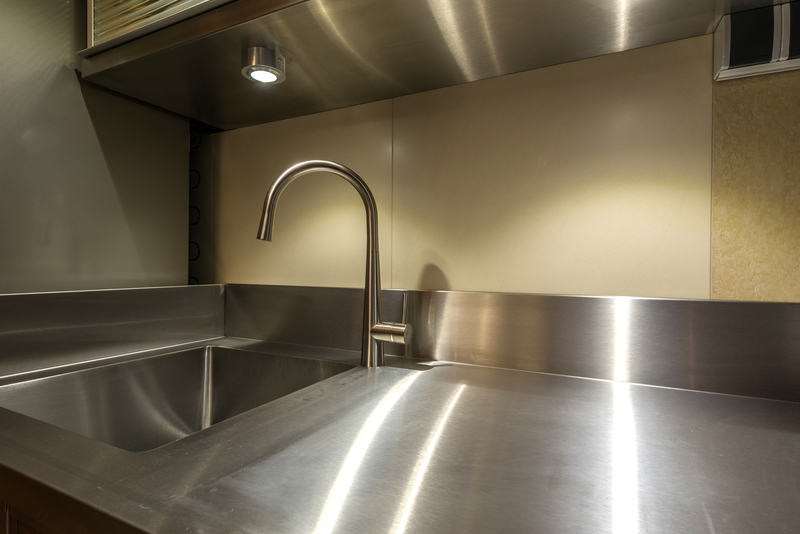Flawlessly Clean Your Stovetop by Tackling Burnt-on Residue
Posted on 25/09/2025
Flawlessly Clean Your Stovetop by Tackling Burnt-on Residue
Is your once-sparkling stovetop marred by stubborn, burnt-on residue and unsightly stains? If you want to flawlessly clean your stove top and restore its original shine, you've arrived at the right place. Stovetops are kitchen workhorses: from boiling, frying, and simmering, they witness daily culinary adventures. However, with frequent use comes the inevitable build-up of cooked-on grime, grease splatters, and burned leftovers. These can seem impossible to remove - unless you know the best method!
This comprehensive guide will walk you through step-by-step instructions, tried-and-true cleaning techniques, and essential maintenance tips to help you tackle stubborn, burnt-on residue and keep your stovetop in pristine condition.
Why Does Burnt-on Residue Accumulate on Stovetops?
Before learning the secrets to a flawlessly clean stovetop, it helps to understand why stubborn residue develops in the first place. Several factors come into play:
- Spills and Overflows: Boiling liquids or bubbling sauces can overflow, burning onto the heat source.
- High Cooking Temperatures: Frequent high-heat cooking can carbonize food particles, creating tough, blackened patches.
- Grease Spatters: Grease from frying tends to spread and settle as sticky, burnt-on residue.
- Neglected Spills: Delayed cleaning allows spills to set and harden, making removal more difficult.
Regular maintenance keeps these issues at bay, but life gets busy. Let's explore how to clean burnt-on residue from your stovetop, regardless of how long it's been there.

Types of Stovetops and Cleaning Considerations
Understanding your stovetop's material is crucial for choosing the safest and most effective cleaning method. Here are the main types:
- Gas Stovetops: Feature removable grates and burners. Food and grease often collect around burners and in drip pans.
- Electric Coil Stovetops: Have raised, removable burner coils. Residue accumulates on drip pans beneath the coils.
- Glass or Ceramic Stovetops: Boast a smooth, flat surface. While easy to wipe, burnt-on residue and scratches can be challenging and require gentler products.
- Induction Stovetops: Similar to glass tops but use electromagnetic heating. Typically easier to clean but still vulnerable to tough, burnt-on marks.
Safety First: Always unplug electric stoves, and ensure your stovetop is completely cool before cleaning.
Essential Supplies for Stovetop Cleaning
Gather the following supplies before tackling stubborn residue:
- Soft microfiber cloths and non-scratch sponges
- Mild dish soap
- Baking soda
- White vinegar
- Plastic scraper (for glass/ceramic tops)
- Old toothbrush
- Warm water
- Optional: Specialized stovetop cleaner or degreasing spray
- Rubber gloves for protection
Step-by-Step Guide: Removing Burnt-on Residue from Stovetops
Step 1: Preparation and Initial Wipe-Down
- Ensure the stovetop is completely cold to touch.
- Remove all grates, burner caps, and knobs (if detachable). Soak these in hot, soapy water.
- Wipe the stovetop surface with a damp microfiber cloth to remove loose debris and crumbs.
Step 2: Tackling Burnt Food Residue
- Sprinkle baking soda liberally over the affected areas. Baking soda acts as a gentle abrasive and absorbs grease.
- Saturate a clean cloth or paper towel with vinegar, then lay it over the baking soda so the mixture starts fizzing. This helps break down stubborn stains.
- Allow the solution to sit for 15-20 minutes (or up to 30 minutes for severe residue).
- Gently scrub the spot in circular motions with a non-scratch sponge or cloth. For glass tops, use a plastic scraper at a low angle to carefully lift off the residue.
Step 3: Deep Cleaning Stubborn Stains
- Mix a paste of 3 parts baking soda to 1 part water; apply it directly to burnt marks, spreading evenly with a spoon or spatula.
- Let the paste dry for 20-30 minutes. As it dries, it loosens stubborn, baked-on gunk.
- For severe black residue, you can use a little commercial degreaser, but always check your stovetop manufacturer's recommendations first.
- Scrub again with a damp, soft cloth, or for intricate spots use an old toothbrush to reach nooks and crannies.
Step 4: Detailed Attention for Grates, Burner Covers, and Knobs
- After soaking, use a sponge or brush and a little more baking soda to scrub these pieces clean.
- Rinse and allow to dry completely before reassembling.
- For heavily encrusted grates, an overnight soak with a touch of ammonia (in a sealed bag, away from children and pets) can work wonders. Always rinse thoroughly afterward.
Step 5: Final Rinse and Buff
- Wipe down the entire stovetop with a fresh, dampened microfiber cloth to remove all cleaning residues.
- Buff dry with a separate, clean microfiber cloth for a streak-free finish.
Tip: For glass and ceramic stovetops, a final polish using a dedicated glass cleaner can enhance shine and prevent smudges.
Special Tips for Different Stovetop Surfaces
Gas Stovetops
- Check gas ports on burners for obstructions. Use a straightened paperclip to clear clogs (never use toothpicks).
- Wipe drip pans thoroughly. For persistent stains, soak in vinegar overnight.
Electric Coil Stovetops
- Never immerse coils directly in water. Wipe with a damp cloth and use baking soda paste for spots.
- Remove drip pans for a soak and scrub; replace if too damaged.
Glass and Ceramic Stovetops
- Avoid steel wool or abrasive powders, as these will scratch the surface.
- Use only plastic or silicone scrapers, and always follow manufacturer guidelines.
- For cooked-on sugar spills, address immediately as they can permanently damage the glass.
Best Homemade Cleaners for Burnt-on Stovetop Residue
If you're avoiding harsh chemicals, several DIY cleaning solutions effectively clean stovetops with burnt-on food:
- Baking Soda + Vinegar: The classic combo for breaking down tough grime.
- Lemon Juice: The acidity of lemon helps dissolve grease and leaves a fresh scent.
- Hydrogen Peroxide + Baking Soda Paste: Ideal for tackling stubborn black marks. Let sit for 10-15 minutes before scrubbing.
- Hot, Soapy Water: Don't underestimate this simple solution for loosening burnt residue with a little soaking time.
Preventing Burnt-on Residue: Maintenance Habits for a Flawlessly Clean Stovetop
Once your stovetop is pristine, keep it that way with these preventative maintenance tips:
- Wipe up spills as soon as possible. The longer they sit, the harder they are to remove.
- Clean the stovetop weekly to stop grease and residue from building up.
- Place spoon rests or splatter guards to catch drips during cooking.
- Use the appropriate heat setting and size of cookware for each burner to avoid accidental overflows.
- Deep clean removable parts (grates, drip pans, knobs) every few weeks.
- Promptly address sugar spills on glass or ceramic tops to avoid etching.
Common Mistakes to Avoid When Cleaning Your Stovetop
- Using abrasive scrubbers or harsh chemicals on delicate surfaces, leading to permanent scratches or discoloration.
- Cleaning before the stovetop cools down, risking burns or injury.
- Neglecting hard-to-reach areas around burners or control knobs, allowing grime to accumulate.
- Reassembling wet components (like burner caps or drip pans) directly onto the stove, potentially causing electrical hazards.

Frequently Asked Questions About Stovetop Cleaning
Can I use oven cleaner on my stovetop?
Oven cleaner is often too harsh, especially for glass and ceramic stovetops. Always consult your stovetop manual and prefer gentler cleaning solutions.
How do I remove melted plastic or sugar from a glass cooktop?
Turn off the burner and let it cool slightly (but not fully, as heat makes removal easier). Carefully scrape softened plastic or sugar off with a plastic scraper, then clean the area with a vinegar-soaked cloth and baking soda paste.
What if my burnt-on residue still won't come off?
Repeat the baking soda/vinegar process or try a commercial stovetop cleaner made for your surface. For extremely stubborn spots, consult your stovetop's manufacturer or a professional cleaner.
Conclusion: Enjoy a Flawlessly Clean, Shimmering Stovetop
Burnt-on residue and greasy buildup are no match for the right cleaning strategies. With patience, suitable supplies, and a regular cleaning routine, you can restore your stovetop's sparkle and maintain a kitchen you're proud of. Whether you're contending with a grimy gas range or a stained glass cooktop, the steps above ensure your stovetop remains flawlessly clean and ready for any culinary challenge.
Remember: Consistent upkeep, gentle products, and prompt action are the keys to effortlessly clean every type of stovetop. Let your kitchen shine!




